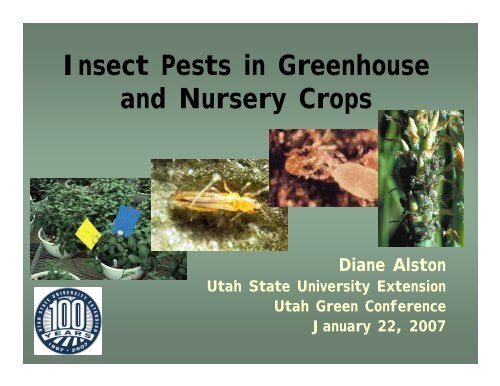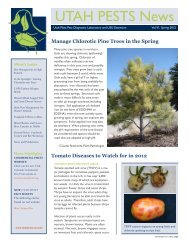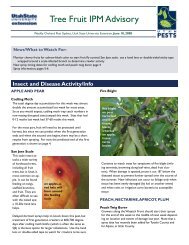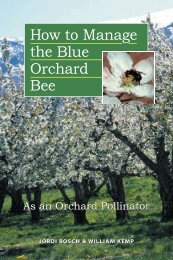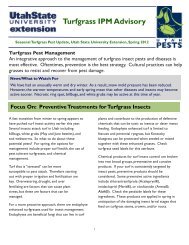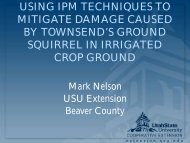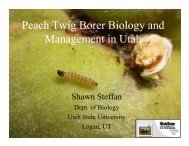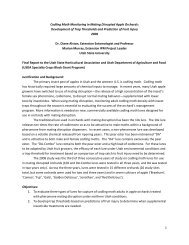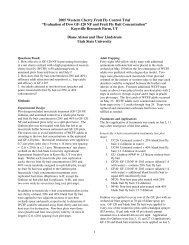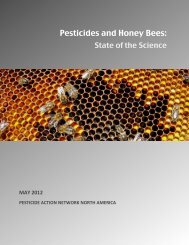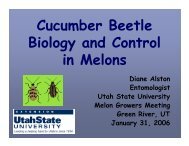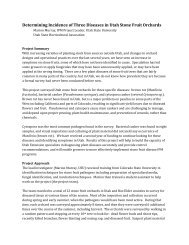Insect Pests in Greenhouse and Nursery Crops - Utah Pests - Utah ...
Insect Pests in Greenhouse and Nursery Crops - Utah Pests - Utah ...
Insect Pests in Greenhouse and Nursery Crops - Utah Pests - Utah ...
You also want an ePaper? Increase the reach of your titles
YUMPU automatically turns print PDFs into web optimized ePapers that Google loves.
<strong>Insect</strong> <strong>Pests</strong> <strong>in</strong> <strong>Greenhouse</strong><br />
<strong>and</strong> <strong>Nursery</strong> <strong>Crops</strong><br />
Diane Alston<br />
<strong>Utah</strong> State University Extension<br />
<strong>Utah</strong> Green Conference<br />
January 22, 2007
Topics<br />
◘ Integrated Pest Management Techniques<br />
◘ <strong>Greenhouse</strong>/Interiorscape <strong>Pests</strong><br />
◘ Whiteflies<br />
◘ Thrips<br />
◘ Spider mites<br />
◘ Aphids, Mealybugs, Fungus gnats, Shore flies<br />
(will not cover today)<br />
◘ Outdoor <strong>Nursery</strong> <strong>Pests</strong><br />
◘ Scales<br />
◘ Aphids<br />
◘ Lilac root weevil<br />
◘ Tree borers<br />
◘ On-l<strong>in</strong>e Resources
<strong>Greenhouse</strong> IPM Techniques*<br />
◘ Integration of cultural, mechanical,<br />
biological, <strong>and</strong> chemical tools<br />
◘ Scout<strong>in</strong>g<br />
◘ Thresholds<br />
*Modified from <strong>Greenhouse</strong> IPM with an Emphasis on Biocontrols,<br />
Pennsylvania IPM Program, Pennsylvania Dept. of Ag. & Penn State U.
Exclusion<br />
◘ Clean transplants!<br />
◘ Inspect <strong>in</strong>com<strong>in</strong>g plants &<br />
materials<br />
◘ Keep doors closed!<br />
◘ Screen open<strong>in</strong>gs<br />
◘ Doors, ventilation open<strong>in</strong>gs<br />
◘ Barren/Clean floor surfaces<br />
◘ Concrete, black plastic, weed<br />
barrier<br />
◘ Limit access<br />
◘ People, “pet plants”, nonessential<br />
materials
Cultural Control<br />
◘ Ma<strong>in</strong>ta<strong>in</strong> healthy, resistant<br />
plants<br />
◘ Choose resistant species <strong>and</strong><br />
cultivars when available<br />
◘ <strong>Greenhouse</strong> environment<br />
◘ Temperature, light/dark cycles,<br />
humidity<br />
◘ Time of plant<strong>in</strong>g <strong>and</strong> harvest<br />
◘ Irrigation<br />
◘ Fertilization<br />
◘ Rotate crops between houses<br />
◘ Soil/soil-less media
Sanitation<br />
◘ Weed management<br />
◘ Weed-free <strong>in</strong>side <strong>and</strong> zone around<br />
outside perimeter<br />
◘ Post-harvest clean up<br />
◘ Remove <strong>and</strong> destroy all plant<br />
materials <strong>in</strong>clud<strong>in</strong>g weeds<br />
◘ Pressure-wash, dis<strong>in</strong>fect<br />
◘ Increase temperature to >80ºF<br />
◘ Constant light<br />
◘ Elim<strong>in</strong>ate st<strong>and</strong><strong>in</strong>g water & algae<br />
(food, shelter)<br />
◘ Sterilize soil/growth media<br />
◘ Place sticky traps to monitor pests<br />
before mov<strong>in</strong>g <strong>in</strong> new plants
Scout<strong>in</strong>g<br />
◘ Cornerstone of IPM<br />
◘ Allows for early detection &<br />
treatment<br />
◘ Scout weekly<br />
◘ Designate 1-2 employees &<br />
provide tra<strong>in</strong><strong>in</strong>g<br />
◘ Tools<br />
◘ H<strong>and</strong> lens, sticky traps (yellow &<br />
blue), record book, flagg<strong>in</strong>g,<br />
vials, forceps, pH meter, soluble<br />
salt meter, m<strong>in</strong>/max<br />
thermometer
Scout<strong>in</strong>g (cont.)<br />
◘ Ma<strong>in</strong>ta<strong>in</strong> a notebook/records<br />
◘ Allow at least 3 hr per acre<br />
◘ Scout least-<strong>in</strong>fested first,<br />
heavily <strong>in</strong>fested areas last<br />
◘ Zigzag pattern, m<strong>in</strong>imum of 10<br />
spots per 1,000 sq ft<br />
◘ Comb<strong>in</strong>e sticky traps with crop<br />
<strong>in</strong>spection<br />
◘ Flag pest hotspots for extra<br />
treatment (biocontrol release,<br />
pesticide)
Sticky Traps<br />
◘ Early detection of adults<br />
◘ May not be a good <strong>in</strong>dicator of actual <strong>in</strong>jury<br />
◘ Presence, thresholds, tim<strong>in</strong>g, evaluate<br />
effectiveness<br />
◘ Color<br />
◘ Yellow, Blue (thrips)<br />
◘ Placement<br />
◘ At least 1 card per 1,000 sq ft<br />
◘ Replace weekly & after a treatment<br />
◘ 1-2 <strong>in</strong>ches above plant canopy<br />
◘ Near favored hosts<br />
◘ Reduce number if releas<strong>in</strong>g w<strong>in</strong>ged beneficial <strong>in</strong>sects<br />
◘ Elim<strong>in</strong>ate blue traps if us<strong>in</strong>g bumble bees for poll<strong>in</strong>ation
Identify<strong>in</strong>g <strong>in</strong>sects on sticky traps<br />
Aphids<br />
Parallel ve<strong>in</strong>s<br />
Shore flies<br />
Short antennae<br />
Long<br />
antennae<br />
Fungus gnats<br />
Y-shaped<br />
ve<strong>in</strong><br />
Legs & antennae long<br />
& th<strong>in</strong><br />
Thrips<br />
Segmented<br />
antennae<br />
Pale<br />
spots<br />
on w<strong>in</strong>gs<br />
Size of fruit fly<br />
Small, dark, mosquitolike<br />
flies with gray w<strong>in</strong>gs<br />
Whiteflies<br />
Hairy w<strong>in</strong>gs<br />
White wax<br />
dissolves <strong>in</strong><br />
adhesive,<br />
Orange<br />
underneath
Other Scout<strong>in</strong>g Methods<br />
◘ Indicator plants<br />
◘ Susceptible varieties<br />
provide an early detection<br />
system<br />
◘ Petunia varieties – thrips;<br />
not a reservoir for viruses<br />
◘ Cucumbers – whiteflies;<br />
concentrate release of<br />
parasitic wasps on cucs<br />
◘ Plant <strong>in</strong>spection<br />
◘ Count the number of pest<br />
<strong>in</strong>sects per leaf or per<br />
plant – use to assess if<br />
threshold’s been reached<br />
Indicator plant for thrips:<br />
‘Carpet Blue’ Petunia
Pest Thresholds<br />
◘ Economic<br />
◘ Pest density when<br />
economic losses are<br />
reached (po<strong>in</strong>t when<br />
value of crop loss<br />
exceed cost of treat<strong>in</strong>g)<br />
◘ Aesthetic<br />
◘ Pest density that causes<br />
unacceptable visual<br />
<strong>in</strong>jury<br />
Thrips <strong>in</strong>jury to leaves &<br />
flower petals
Whiteflies<br />
• Homoptera: Aleyrodidae<br />
• Pierc<strong>in</strong>g-suck<strong>in</strong>g mouthparts<br />
• Suck sap<br />
• Produce sticky honeydew<br />
Silverleaf whitefly holds w<strong>in</strong>gs<br />
• Silverleaf whitefly<br />
close to body, roof-like<br />
• Bemisia argentifolii<br />
• Po<strong>in</strong>settias, ornamentals<br />
• Transmits > 25 viruses<br />
• <strong>Greenhouse</strong> whitefly<br />
• Trialeurodes vaporariorum<br />
• Vegetables, ornamentals<br />
<strong>Greenhouse</strong> whitefly holds w<strong>in</strong>gs<br />
flat, horizontally
Whiteflies<br />
• 1 st <strong>in</strong>star nymph –<br />
crawler<br />
• 2 nd & 3 rd <strong>in</strong>star<br />
nymphs -feed<br />
• 4 th <strong>in</strong>star – doesn’t<br />
feed, pupa<br />
• 30 day life cycle<br />
• Foliage pest; secrete<br />
honeydew; sooty mold<br />
• Leaves turn yellow,<br />
dry, drop from plant
Whitefly Scout<strong>in</strong>g<br />
• Monitor to detect<br />
presence – yellow<br />
sticky cards<br />
• Trap threshold = ½<br />
per card per day<br />
when crop is young,<br />
2 per card per day<br />
when crop<br />
approaches maturity<br />
• Inspect plants –<br />
h<strong>and</strong> lens<br />
• Leaf threshold = 10<br />
nymphs per leaf
Whitefly Management<br />
• Biocontrol can be very<br />
successful<br />
• <strong>Insect</strong>icide options<br />
• Range of modes of action<br />
• Reduced toxicity choices<br />
• Problems with <strong>in</strong>secticide use:<br />
• Develop resistance quickly<br />
• Rotate chemical type regularly<br />
• Conf<strong>in</strong>ed system – applicator<br />
safety concerns<br />
• Fresh market crop – short<br />
residuals<br />
• Phytotoxicity to crop<br />
Encarsia wasp pupae<br />
on card
Whitefly <strong>Insect</strong>icides*<br />
• IGR- Juvenile hormone mimic:<br />
• k<strong>in</strong>oprene; Enstar<br />
• fenoxycarb; Precision<br />
• pyriproxyfen; Distance<br />
• IGR- Ecdysone disruptor:<br />
• neem oil; Azat<strong>in</strong><br />
• IGR- Chit<strong>in</strong> synthesis<br />
<strong>in</strong>hibitor:<br />
• diflubenzuron; Adept<br />
• novaluron; Pedastal<br />
• Chloronicot<strong>in</strong>yl:<br />
• imidacloprid; Marathon<br />
• acetamiprid; Tristar<br />
• thiamethoxam; Flagship<br />
• Pyrethroid:<br />
• bifenthr<strong>in</strong>; Talstar<br />
• cyfluthr<strong>in</strong>; Decathlon,Tempo,<br />
• fenpropathr<strong>in</strong>; Tame<br />
• lambda-cyhalothr<strong>in</strong>; Scimitar<br />
• Organochlor<strong>in</strong>e:<br />
• endosulfan; Thiodan<br />
• pyridaben; Sanmite<br />
• Miscellaneous:<br />
• flonicamid; F1785 GH<br />
• pymetroz<strong>in</strong>e; Endeavor<br />
• Suffocants, cuticle disruptants:<br />
• <strong>Insect</strong>icidal soap; Horticultural<br />
m<strong>in</strong>eral oil<br />
*Registered on commercial, non-edible greenhouse crops
Whitefly Biocontrol<br />
• Can be very successful<br />
• Parasitic wasps – Encarsia, Eretmocerus<br />
• Predators – Delphastus ladybeetle,<br />
lacew<strong>in</strong>g<br />
• Pathogenic fungi – Beauveria (BotaniGard)
Encarsia Program<br />
• Parasitizes whitefly early nymphal stages<br />
• 10 nymphs per leaf will susta<strong>in</strong> wasp<br />
• 2 schemes for use:<br />
• At whitefly threshold density, release wasps at<br />
1/sq-ft grnhse space, check for whitefly<br />
hotspots <strong>and</strong> release more<br />
• Cucumber plants at ends of rows; whiteflies will<br />
concentrate on cucs, target cucs for wasp<br />
release<br />
• Cannot use <strong>in</strong>secticides
Thrips<br />
◘ Western flower thrips<br />
◘ Frankl<strong>in</strong>iella occidentalis<br />
◘ Vector of major viruses<br />
• Impatiens necrotic r<strong>in</strong>gspot<br />
• Tomato spotted wilt<br />
◘ Virus acquired by 1 st <strong>in</strong>star<br />
nymphs, transmitted by<br />
adults<br />
◘ Eggs <strong>in</strong>serted <strong>in</strong>to leaves &<br />
buds; 150-300 eggs per<br />
female<br />
◘ 10-14 day life cycle
Thrips Injury<br />
◘ Punch-<strong>and</strong>-suck feed<strong>in</strong>g<br />
style<br />
◘ Tissue appears rasped,<br />
streaked, silvery<br />
◘ Vector viruses
Thrips Scout<strong>in</strong>g<br />
◘ Early detection is critical<br />
◘ Blue sticky traps<br />
◘ 1 trap per 1,000 sq ft<br />
◘ Place just above canopy<br />
◘ Inspect blossoms, buds, leaves<br />
◘ Tap leaves & blossoms over white sheet of<br />
paper<br />
◘ ETs:<br />
◘ 5-20 per trap <strong>in</strong> chrysanthemums<br />
◘ Indicator plants – place every 20-30 ft<br />
◘ ‘Carpet Blue’ <strong>and</strong> ‘Blue Madness” Petunias<br />
◘ Not reservoirs for INSV
Thrips Management<br />
◘ Difficult, <strong>in</strong>secticide<br />
resistance<br />
◘ Biocontrol alone<br />
often is not enough<br />
◘ Sanitation is key!<br />
◘ Clean stock, no debris<br />
◘ Exclusion, screen<br />
vents<br />
◘ 20-ft vegetation free<br />
zone around house
Thrips Biocontrol<br />
◘ Predatory mite, Neoseiulus cucumeris<br />
◘ Predatory soil mite, Hypoaspis miles<br />
◘ M<strong>in</strong>ute pirate bug, Orius <strong>in</strong>sidiosus<br />
Neoseiulus cucumeris<br />
Hypoaspis miles feed<br />
on thrips pupae <strong>in</strong> the<br />
soil<br />
M<strong>in</strong>ute pirate bug adult
Twospotted Spider Mite<br />
• Foliage pest; feeds on epidermis &<br />
mesophyll, suppresses photosynthesis<br />
• Causes stippl<strong>in</strong>g, bronz<strong>in</strong>g of leaves<br />
• Produce f<strong>in</strong>e webb<strong>in</strong>g<br />
• Mites go dormant <strong>in</strong> fall, orange <strong>in</strong><br />
color (photoperiod <strong>in</strong>duced)
Cultural Management of Mites<br />
• Prevent diapause of mite <strong>in</strong> the fall<br />
• Interrupt night with 2 hr light<br />
• Keeps mites active<br />
• Remove crop & starve mites<br />
• Clean up with <strong>in</strong>secticidal soap,<br />
horticultural oil or acaricide
Mite Biological Control<br />
• Predatory mite – Phytoseiulus persimilis<br />
• Release predator <strong>in</strong> ground corn cob<br />
carrier<br />
• 1 st year: 1/5 plants <strong>in</strong>fested with TSSM<br />
or release TSSM with predator, release<br />
predator (4 preds/<strong>in</strong>fested TSSM plant),<br />
monitor, redistribute TSSM if preds<br />
consume all prey <strong>in</strong> an area<br />
• Subsequent years: release preds <strong>in</strong><br />
TSSM hotspots; can establish for many<br />
years<br />
• No toxic pesticides
Spider Mite Management<br />
◘ Soft Controls: pressurized<br />
stream of water, horticultural<br />
oils, <strong>in</strong>secticidal soap<br />
◘ New miticides:<br />
◘ Acequ<strong>in</strong>ocyl (Kanemite, Shuttle)<br />
◘ Bifenazate (Floramite)<br />
◘ Pyridaz<strong>in</strong>one (Akari, Nexter,<br />
Sanmite)<br />
◘ Chlorfenapyr (Pylon)<br />
◘ Etoxazole (Tetrazan)<br />
◘ Hexythiazox (Ovation, Hexagon)<br />
Spruce spider mite<br />
Predaceous mite feed<strong>in</strong>g on<br />
spider mite
Outdoor <strong>Nursery</strong> <strong>Pests</strong>
Scale <strong>Insect</strong>s<br />
◘ Soft scales feed <strong>in</strong><br />
phloem, produce sticky<br />
honeydew<br />
◘ Armored scales feed<br />
on mesophyll of plant<br />
cells, do not produce<br />
honeydew<br />
◘ Multiple years of scale<br />
feed<strong>in</strong>g can kill limbs;<br />
cause dieback<br />
European fruit lecanium<br />
scale<br />
San Jose scale & <strong>in</strong>jury
Scale Biology<br />
◘ 1-2 generations per<br />
summer<br />
◘ Overw<strong>in</strong>ter as eggs<br />
or young nymphs<br />
◘ Females are sessile<br />
◘ Males have w<strong>in</strong>gs<br />
◘ “Crawler” stage is<br />
the best target for<br />
control<br />
Oystershell scale female<br />
surrounded by crawlers
Scale Management<br />
◘ Delayed Dormant Control is<br />
effective for soft scales & some<br />
armored scales: Dormant oil +<br />
Pyrethroid (at first bud break)<br />
◘ Use sticky tape <strong>in</strong> late spr<strong>in</strong>g to<br />
early summer to time a spray for<br />
“crawlers”<br />
◘ Soft scales: Merit (systemic),<br />
Precision, Flagship, horticultural oil,<br />
<strong>in</strong>secticidal soap<br />
◘ Armored scales: pyrethroids or<br />
others timed with crawlers<br />
Oystershell scale<br />
P<strong>in</strong>e needle scale
Aphids<br />
◘ Suck sap from phloem tubes <strong>in</strong><br />
leaves <strong>and</strong> stems<br />
◘ Curl leaves, produce sticky<br />
honeydew that promotes growth<br />
of black sooty mold, reduce<br />
plant vigor at high densities<br />
◘ Populations <strong>in</strong>crease rapidly, low<br />
numbers can be tolerated<br />
◘ Only control if honeydew is a<br />
nuisance problem or distortion<br />
of leaves is severe <strong>and</strong> aphid<br />
numbers are very high<br />
◘ Many generations per summer<br />
Apple aphid curls leaves<br />
Giant willow aphid feeds<br />
on limbs<br />
Sooty mold
Aphid Biology<br />
Alternate hosts<br />
Woody overw<strong>in</strong>ter<strong>in</strong>g<br />
host<br />
Aphid eggs<br />
on tree limbs<br />
Woody or<br />
herbaceous<br />
summer host<br />
Only females,<br />
bear young live<br />
Cont<strong>in</strong>ual, overlapp<strong>in</strong>g<br />
generations<br />
Mostly a spr<strong>in</strong>g pest<br />
Fruit tree aphids<br />
plum, peach, rosy apple,<br />
cherry<br />
Spirea<br />
Dogwood<br />
Woolly elm<br />
Woolly alder<br />
Honeysuckle<br />
Rose<br />
Woolly Maple<br />
Poplar<br />
Ash<br />
Cottonwood
Aphid Biology<br />
S<strong>in</strong>gle host<br />
Produce overw<strong>in</strong>ter<strong>in</strong>g eggs<br />
<strong>in</strong> colder climates<br />
Birch aphid<br />
C<strong>in</strong>ara conifer<br />
aphid<br />
Season-long pest<br />
Apple<br />
Birch<br />
Poplar<br />
Cottonwood<br />
Walnut<br />
Conifers<br />
Sycamore<br />
Maple<br />
Pecan<br />
Hackberry<br />
Elm
Aphid Management<br />
◘ Delayed Dormant Spray:<br />
Dormant oil + Pyrethroid (at<br />
bud break)<br />
◘ Spr<strong>in</strong>g <strong>and</strong> Summer control:<br />
hard spray of water,<br />
horticultural oil, <strong>in</strong>secticidal<br />
soap, imidacloprid (Merit,<br />
systemic), Conserve, Aria,<br />
azadiracht<strong>in</strong>, Orthene,<br />
pyrethroids, others<br />
◘ Biological control: lady beetles,<br />
lacew<strong>in</strong>gs, syrphid flies,<br />
parasitic wasps<br />
Syrphid fly larva<br />
Lacew<strong>in</strong>g larva<br />
Aphid mummies
<strong>Insect</strong>icide Resistance Management<br />
◘ Rotate chemical classes / modes of<br />
action<br />
◘ With<strong>in</strong> a generation<br />
◘ Between generations with<strong>in</strong> a season<br />
Aphid giv<strong>in</strong>g birth<br />
to live nymph
Lilac Root Weevil<br />
Drought related<br />
Observed heavy <strong>in</strong>jury<br />
to shrubs & small trees
Lilac Root Weevil<br />
Otiorhynchus meridionalis<br />
◘ Common hosts: lilac, peony,<br />
dogwood, yew, privet,<br />
cotoneaster, arbovitae, spruce,<br />
others<br />
◘ Adults chew irregular notches <strong>in</strong><br />
leaf edges – target with foliar<br />
<strong>in</strong>secticide (Orthene, Merit,<br />
Sev<strong>in</strong>, Azadiracht<strong>in</strong>, Pyrethroids)<br />
– <strong>in</strong> late spr<strong>in</strong>g with first leaf<br />
notch<strong>in</strong>g<br />
◘ Larvae feed on roots – target<br />
with soil <strong>in</strong>secticide (Merit),<br />
<strong>in</strong>sect-attack<strong>in</strong>g nematodes,<br />
Beauveria fungus – late spr<strong>in</strong>g or<br />
early fall<br />
Adult & leaf notch<strong>in</strong>g<br />
Needle notch<strong>in</strong>g on spruce<br />
Larvae feed<strong>in</strong>g on crown<br />
& roots
Tree <strong>and</strong> Shrub <strong>Insect</strong> Borers<br />
◘ Attack trunks & limbs:<br />
◘Roundheaded & Flatheaded Beetles,<br />
Clearw<strong>in</strong>g Moths<br />
◘ Attack cambium under bark:<br />
◘Bark Beetles – Ips, B<strong>and</strong>ed Elm<br />
Bark Beetle
Longhorned Beetles/Roundheaded Borers<br />
(Cerambycidae)<br />
P<strong>in</strong>e Sawyer<br />
Aspen borer<br />
Poplar<br />
Cottonwood<br />
Locust<br />
Ash<br />
Fruit trees<br />
P<strong>in</strong>e Most only attack stressed trees<br />
Tunnel through cambium <strong>and</strong> <strong>in</strong>to <strong>in</strong>ner wood<br />
Locust borer
Metallic Wood Bor<strong>in</strong>g Beetles/<br />
Flatheaded Borers (Buprestidae)<br />
Bronze<br />
Birch<br />
Borer<br />
Birch<br />
Beech<br />
Fruit trees<br />
Maple<br />
D-shaped exit<br />
holes<br />
Most only attack stressed trees<br />
Feed just under bark <strong>in</strong> cambium –<br />
girdle trunk<br />
Apple<br />
Flatheaded<br />
Borer
Clearw<strong>in</strong>g Moth Borers (Sessiidae)<br />
Lilac Ash Borer<br />
Western Poplar Clearw<strong>in</strong>g<br />
Ash<br />
Lilac<br />
Cottonwood<br />
Poplar<br />
Willow<br />
Prunus<br />
Will attack healthy trees<br />
Tunnel <strong>in</strong>to <strong>in</strong>ner wood<br />
Greater Peachtree Borer
Tim<strong>in</strong>g of Adult Tree Borer<br />
Activity<br />
◘ Adult flight periods for northern<br />
<strong>Utah</strong><br />
• Ash/Lilac borer – May 1- late June<br />
• Bronze birch borer – late May – June<br />
• Aspen borer – May-July<br />
• Peachtree (Crown) borer – late June –<br />
August<br />
• Poplar-<strong>and</strong>-Willow borer – July – Sept.<br />
• Locust borer – August – Sept.<br />
• Shothole borer – June <strong>and</strong> late Sept.
<strong>Insect</strong>icides for Preventive<br />
Trunk Sprays<br />
◘ Contact:<br />
◘ carbaryl (Sev<strong>in</strong>), endosulfan (Thionex),<br />
pyrethroids (permethr<strong>in</strong>, bifenthr<strong>in</strong>)<br />
◘ Systemic (translocation activity):<br />
◘ Taken up by roots & moved throughout<br />
plant through xylem & phloem<br />
◘ Can also act as a local systemic<br />
• imidacloprid (Merit, Marathon, Bayer<br />
Advanced Garden Tree & Shrub <strong>Insect</strong><br />
Control)
Imidacloprid<br />
◘ Merit, Marathon, Bayer Advanced<br />
Garden Tree & Shrub <strong>Insect</strong> Control<br />
◘ Soil drench, soil <strong>in</strong>jection, foliar<br />
◘ Soil: translocation delay of up to 60 days or<br />
longer<br />
◘ N conta<strong>in</strong><strong>in</strong>g fertilizer may enhance uptake<br />
◘ Target <strong>in</strong>sects: soft-bodied pests on leaves<br />
<strong>and</strong> limbs (aphids, adelgids, leafm<strong>in</strong>ers, leaf<br />
beetles, mealybugs, psyllids, scale); white<br />
grub larvae; roundheaded borers<br />
(suppressive), flatheaded borers (control)<br />
◘ Clearw<strong>in</strong>g moth larvae are not on the label
Considerations for Us<strong>in</strong>g Systemics<br />
◘ Long-last<strong>in</strong>g activity<br />
◘ Reduced degradation by UV & water<br />
◘ M<strong>in</strong>imize plant surface residues<br />
◘ M<strong>in</strong>imize human exposure<br />
◘ Application can be more convenient<br />
◘ Delayed uptake & availability<br />
◘ <strong>Insect</strong> resistance concerns
Bark Beetles (Scolytidae)<br />
Spruce<br />
P<strong>in</strong>e<br />
Fir<br />
Prunus<br />
Elm Attack old or stressed trees<br />
& seem<strong>in</strong>gly healthy trees
Trees at Risk for Ips Attack<br />
◘ Stressed trees:<br />
◘ Drought-stressed, trees <strong>in</strong> dry sites<br />
◘ Newly transplanted<br />
◘ Root <strong>in</strong>juries from construction or<br />
other<br />
◘ Crowded trees<br />
◘ Trees surrounded by breed<strong>in</strong>g<br />
populations of Ips<br />
◘ Slash (piles of prun<strong>in</strong>gs)<br />
◘ Stacks of green or <strong>in</strong>fested wood<br />
• Freshly cut wood is a preferred breed<strong>in</strong>g<br />
site
Management of Ips <strong>in</strong> the<br />
L<strong>and</strong>scape<br />
• Ma<strong>in</strong>ta<strong>in</strong> tree vigor, avoid stress (proper<br />
water<strong>in</strong>g, plant<strong>in</strong>g site, avoid <strong>in</strong>juries)<br />
• 2-4” water every 2-6 weeks<br />
• Avoid plant<strong>in</strong>g <strong>in</strong> very dry sites<br />
• Remove & dispose of <strong>in</strong>fested material<br />
• Dispose 2-3 miles away from hosts<br />
• Remove <strong>and</strong> treat <strong>in</strong>fested material<br />
• Chip <strong>and</strong> spread to dry<br />
• Burn<br />
• Remove all bark<br />
• Cover logs with >10 ml clear plastic & heat<br />
to lethal temperatures
Management of Ips <strong>in</strong> the L<strong>and</strong>scape<br />
◘ Apply preventive <strong>in</strong>secticide or<br />
apply to “lightly” <strong>in</strong>fested trees:<br />
• Carbaryl (Sev<strong>in</strong>): flowable, 2% ai<br />
solution<br />
• Permethr<strong>in</strong> (Astro, Dragnet)<br />
• Treat <strong>in</strong> spr<strong>in</strong>g before beetle flight<br />
(April) or treat <strong>in</strong> fall (late Sep to<br />
Oct)<br />
• 12-18 months protection (carbaryl)<br />
• High-pressure sprayer (>250 psi) for<br />
large trees<br />
• Apply to entire bole & larger limbs
B<strong>and</strong>ed Elm Bark Beetle<br />
Scolytus schevyrewi<br />
Elm<br />
Prunus<br />
Willow<br />
Russian Olive<br />
Attack<strong>in</strong>g American elm trees<br />
May vector the Dutch Elm Disease fungus
<strong>Utah</strong> <strong>Pests</strong> Web Page<br />
http://utahpests.usu.edu
<strong>Utah</strong> IPM Web Page<br />
http://utahpests.usu.edu/ipm
<strong>Greenhouse</strong> IPM Manual<br />
<strong>Greenhouse</strong> IPM with an Emphasis on Biocontrols<br />
Pennsylvania Integrated Pest Management Program<br />
Free downloadable PDF file:<br />
http://paipm.cas.psu.edu/NewsReleases/ghmanual.html<br />
Order a hard copy from<br />
Publications Distribution Center<br />
Pennsylvania State University<br />
112 Agricultural Adm<strong>in</strong>istrative Bldg.<br />
University Park, PA 16802-2602<br />
$12 + shipp<strong>in</strong>g<br />
1-877-345-0691


